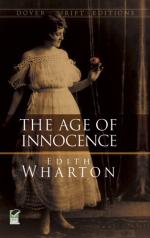The Duke of St. Austrey, who sat at his hostess’s right, was naturally the chief figure of the evening. But if the Countess Olenska was less conspicuous than had been hoped, the Duke was almost invisible. Being a well-bred man he had not (like another recent ducal visitor) come to the dinner in a shooting-jacket; but his evening clothes were so shabby and baggy, and he wore them with such an air of their being homespun, that (with his stooping way of sitting, and the vast beard spreading over his shirt-front) he hardly gave the appearance of being in dinner attire. He was short, round-shouldered, sunburnt, with a thick nose, small eyes and a sociable smile; but he seldom spoke, and when he did it was in such low tones that, despite the frequent silences of expectation about the table, his remarks were lost to all but his neighbours.
When the men joined the ladies after dinner the Duke went straight up to the Countess Olenska, and they sat down in a corner and plunged into animated talk. Neither seemed aware that the Duke should first have paid his respects to Mrs. Lovell Mingott and Mrs. Headly Chivers, and the Countess have conversed with that amiable hypochondriac, Mr. Urban Dagonet of Washington Square, who, in order to have the pleasure of meeting her, had broken through his fixed rule of not dining out between January and April. The two chatted together for nearly twenty minutes; then the Countess rose and, walking alone across the wide drawing-room, sat down at Newland Archer’s side.
It was not the custom in New York drawing-rooms for a lady to get up and walk away from one gentleman in order to seek the company of another. Etiquette required that she should wait, immovable as an idol, while the men who wished to converse with her succeeded each other at her side. But the Countess was apparently unaware of having broken any rule; she sat at perfect ease in a corner of the sofa beside Archer, and looked at him with the kindest eyes.
“I want you to talk to me about May,” she said.
Instead of answering her he asked: “You knew the Duke before?”
“Oh, yes—we used to see him every winter at Nice. He’s very fond of gambling—he used to come to the house a great deal.” She said it in the simplest manner, as if she had said: “He’s fond of wild-flowers”; and after a moment she added candidly: “I think he’s the dullest man I ever met.”
This pleased her companion so much that he forgot the slight shock her previous remark had caused him. It was undeniably exciting to meet a lady who found the van der Luydens’ Duke dull, and dared to utter the opinion. He longed to question her, to hear more about the life of which her careless words had given him so illuminating a glimpse; but he feared to touch on distressing memories, and before he could think of anything to say she had strayed back to her original subject.
“May is a darling; I’ve seen no young girl in New York so handsome and so intelligent. Are you very much in love with her?”




